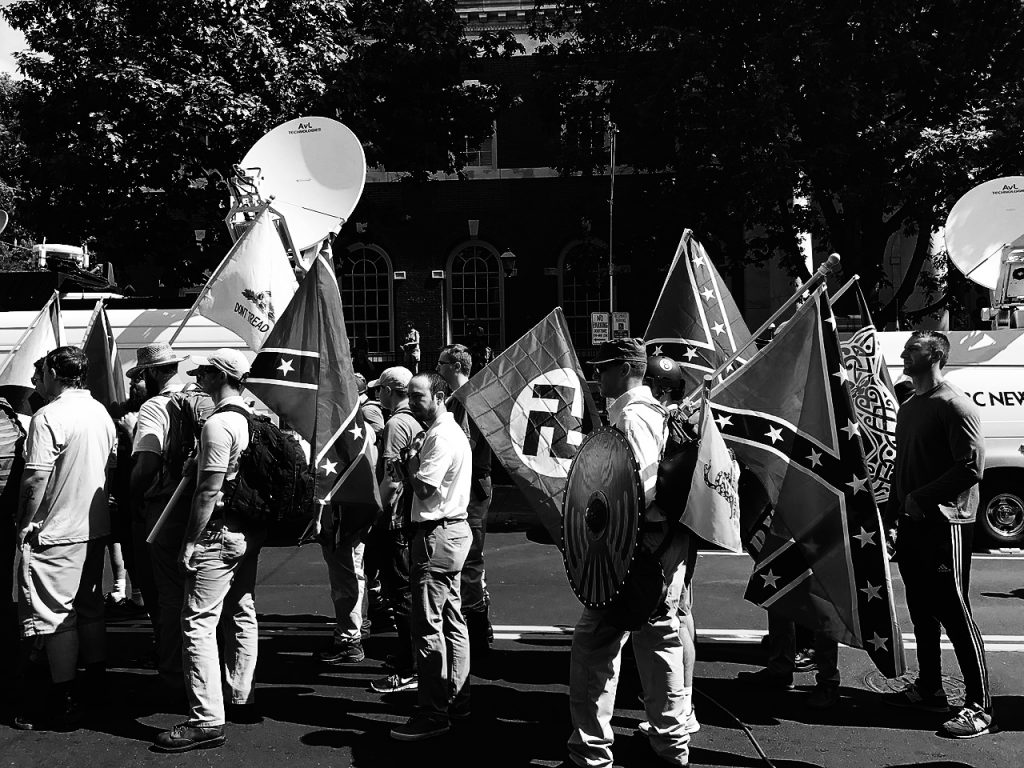Special to the Armenian Weekly
A friend of mine, a zoologist, once told me that chimpanzees are gorgeous animals, and that the recurrent claim they are ugly comes from a fear and a suspicion of resemblance, and not from objective evaluation. The chimpanzee, according to him, is the only animal we judge using our own, human standards of beauty, and we compare it to ourselves and not to other mammals; that is the only reason it comes off as ugly and perhaps too furry for our taste. Otherwise, he said, the chimpanzee is a very beautiful specimen.

A group holding Nazi, Confederate, and Gadsden “Don’t Tread on Me” flags preparing to enter Emancipation Park at the Charlottesville “Unite the Right” rally. (Photo: Anthony Crider)
An amusing example, perhaps, but its inherent conclusion doesn’t need much pondering: Humans tend to exclude that which is the closest to them, that which they most resemble; and we do it naturally and with an ancient comfort. Our first victims are our brothers. The first Biblical murder, after Genesis and before the beginning of time and civilization, was a fratricide.
The smaller the differences, the more we tend to emphasize them. Even if we need recourse to science to prove we are different. Fascists in the first half of the 20th century used biology to distinguish between “superior” and “inferior” races. They used science to delineate differences among humans, and to claim that in the immense book of resemblances there is a secret page, at the end, where our differences are assessed. And that only biology will reveal the invisible ink of their white superiority.
So they started measuring faces, noses, and ears. Cataloging the colors of eyes and mapping the different shades of white in skins. Because only an “exact” science could detect what their eyes could not see: difference between a German Jew and his Christian neighbor.
And that is where all the danger is: When our differences are microscopic, the responses they provoke are nuclear.
So, if you’re reading this and you are white—but a Christian Middle Easterner, or a Latin American, or an Armenian, or a Jew… think again. Because you are perhaps not as white as they want you to be, and so you are too “close” to be spared. Remember that “White” for a white supremacist is not a race but a mixture of the right genes, the proper religion, the correct name, and the appropriate taste in cars, shirts, hobbies, and food. Having only one or a few of those mutable characteristics is not enough. They will dig deeper, wear their magnifying glasses, and go through their catalogs; and you will finally be blamed for lacking full qualifications—then hastily transferred into the railway wagon of the lower races, headed toward that unique station. The last one.
The word has already been uttered: In a Viceland video, a young mother, carrying her two young children, claimed that the solution should be radical, final: a genocide. The camera was fixed on her, an eerie silence lasted for a short while after she pronounced the word. Then a voice: her husband’s. He expressed his love for his wife: “I love you, baby!” And then everybody laughed. End of shot.
Precisely. Laughter is the beginning of all startling tragedies. A smile of disbelief is the first reaction we have to the immense hole that opens up every time a man claims he is superior. The smile transforms then into surprise, then anger, fear, and, finally, regret. Tragedies don’t start with a fantastic setting, a flying monster, and the music of Wagner in the background. The harshest tragedies started with a bit of gossip, a murmur, a light shiver… and a smile.
What happened in Charlottesville tastes like the start of a tragedy in which no one will be safe. And this is not the problem of African Americans, Muslims, and Mexicans alone. What happened in Charlottesville concerns all minorities, independently of how privileged, protected, and powerful they might be. Refusal, condemnation, and resistance should come from all sides. Silence is in many cases complicit agreement. A strong, universal, and clear reaction is needed, because racism leaves no winners behind.
Because everyone is victim when all our geography consists of islands, and our history—deserts.
It is the moral and historical role of those who have suffered racism and exclusion in the past to make sure that what has happened to them will never happen again to anyone else.
Source: Armenian Weekly
Link: Charlottesville: White Is Not a Color
